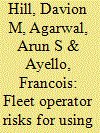|
|
|
Sort Order |
|
|
|
Items / Page
|
|
|
|
|
|
|
| Srl | Item |
| 1 |
ID:
111330


|
|
|
|
|
| Publication |
2012.
|
| Summary/Abstract |
Future fleets of vehicles may include electric vehicles (EVs) or hybrid electric vehicles (HEVs) because of potential fuel savings. Recent demonstration of diesel parallel hybrids in a delivery fleet led to fuel economy improvements, and hybrid bus demonstrations exhibited twice the fuel economy of the conventional bus. Fleet ownership may include management of a fleet of vehicles as small as 10 units and as large as hundreds or thousands. In addition to fuel savings, the newer extended range electric vehicles (EREVs) and pure EVs permit vehicle to grid (V2G) opportunities. These V2G opportunities may present additional revenue for fleets by providing ancillary services to local grid independent system operators (ISOs), provided that the burden of driving and V2G services do not accelerate the degradation of the battery systems in these vehicles. The subject of this study is to determine the financial risks associated with accelerated battery degradation in a V2G-enabled EREV fleet expected to perform ancillary service duty while charging in addition to the normal loads of drive cycle duty. We determine that battery cycle life during V2G duty is a critical parameter, which can determine whether or not the business model is viable.
|
|
|
|
|
|
|
|
|
|
|
|
|
|
|
|
| 2 |
ID:
125709


|
|
|
|
|
| Publication |
2013.
|
| Summary/Abstract |
This paper analyzes the business case of offering secondary downward reserve for frequency control on the German market by a pool of electrical vehicles. Former benchmark studies promised high revenues especially for this case. The benefits could provide an incentive to customers to buy an electric vehicle. The business case is analyzed for the German market as a case study. Specific regulations for this market, real driving patterns and real market data are taken into account when calculating revenues. Secondary reserve is strictly regulated, requiring a very high level of availability. As a result, simulated revenues are lower than assumed. Simulation shows average revenues of less than 5€ per month and vehicle. As a major bottleneck for an offer of secondary reserve, fully charged batteries are identified. Additionally an issue is made of costs for communication and customer compensation. Based on the simulation results, it is argued that the market for secondary reserve should not be accessed with these small units. For electric vehicles, easier accessible markets with lower related costs should be considered instead.
|
|
|
|
|
|
|
|
|
|
|
|
|
|
|
|
| 3 |
ID:
096095


|
|
|
|
|
| Publication |
2010.
|
| Summary/Abstract |
This study investigates plug-in hybrid electric vehicles (PHEVs) as providers of regulating power in the form of primary, secondary and tertiary frequency control. Previous studies have shown that PHEVs could generate substantial profits while providing ancillary services. This study investigates under what conditions PHEVs can generate revenues using actual market data, i.e. prices and activations of regulating power, from Sweden and Germany from four months in 2008. PHEV market participation is modelled for individual vehicles in a fleet subject to a simulated movement pattern. Costs for infrastructure and vehicle-to-grid equipment are not included in the analysis. The simulation results indicate that maximum average profits generated on the German markets are in the range 30-80 € per vehicle and month whereas the Swedish regulating power markets give no profit.
In addition, an analysis is performed to identify strengths, weaknesses, opportunities, and threats (SWOT) of PHEVs as regulating power providers. Based on the simulation results and the SWOT analysis, characteristics for an ideal regulating power market for PHEVs are presented.
|
|
|
|
|
|
|
|
|
|
|
|
|
|
|
|
| 4 |
ID:
115138


|
|
|
|
|
| Publication |
2012.
|
| Summary/Abstract |
The idea that electric vehicles can be used to supply power to the grid for stabilisation and peak time supply is compelling, especially in regions where traditional forms of storage, back up or peaking supply are unavailable or expensive. A number of variants of the vehicle-to-grid theme have been proposed and prototypes have proven that the technological means to deliver many of these are available. This study reviews the most popular variants and investigates their viability using Western Australia, the smallest wholesale electricity market in the world, as an extreme test case. Geographical and electrical isolation prevents the trade of energy and ancillary services with neighbouring regions and the flat landscape prohibits hydroelectric storage. Hot summers and the widespread use of air-conditioning means that peak energy demand is a growing issue, and the ongoing addition to already underutilised generation and transmission capacity is unsustainable. The report concludes that most variants of vehicle-to-grid currently require too much additional infrastructure investment, carry significant risk and are currently too costly to implement in the light of alternative options. Charging electric vehicles can, however, be added to planned demand side management schemes without the need for additional capital investment.
|
|
|
|
|
|
|
|
|
|
|
|
|
|
|
|
|
|
|
|
|